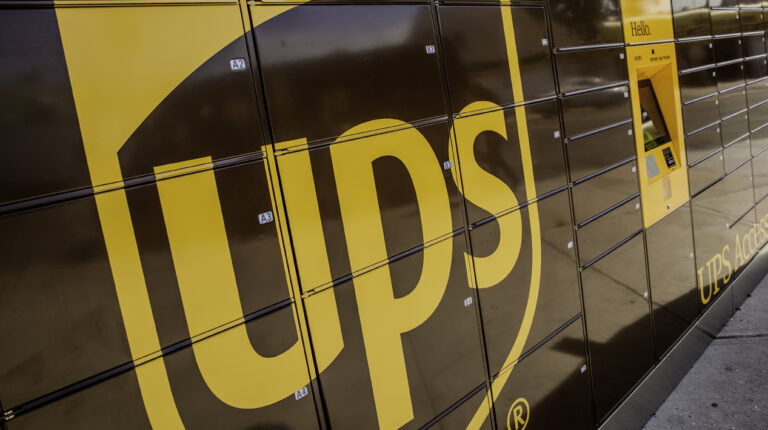In the USA, the USPS, FedEx, UPS and Amazon offer over 70,000 access points. These growing networks have implications for free e-commerce delivery and first-time delivery success. Dean Maciuba, director of consulting services at Logistics Trends & Insights and PRO partner at Last Mile Experts, and Marek Rozycki, managing partner at Last Mile Experts, analyze the market and explain the low penetration of parcel lockers in the USA
In the USA, UPS, FedEx, Amazon and the US Postal Service offer over 70,000 staffed or automated access points where recipients can pick up their parcels – and that number will soon grow to over 80,000 locations.
The primary parcel carriers have been using access points to consolidate low volume pickups/deliveries and drive operational savings for over 35 years. Access points can include:
• Drop boxes
• Mailboxes
• Carrier shipping centers
• Full-service, carrier-authorized outlets
• Parcel lockers
• Third-party retail stores
More recently, UPS and FedEx have been developing hybrid, limited-use access points via retail relationships to support consumer pickup of low volume, e-commerce shipments. These locations do not offer full-service shipping support; however, they are situated perfectly to consolidate multiple e-commerce residential deliveries at a single pickup location. These types of access point facilities (known as PUDOs in other markets) can also act as drop-off points to consolidate consumer drop-off of e-commerce returns and low-volume business shipments.
Reducing the cost of the residential, e-commerce delivery
Making a single-package e-commerce delivery to a residence is a costly proposition for UPS and FedEx. The two mega-carriers would probably be bankrupt if they only delivered e-commerce shipments using current infrastructure. Nevertheless, the growth of e-commerce presents a tremendous revenue opportunity for the carriers, but only if they can reduce the operational cost of e-commerce delivery.
Low-volume residential deliveries will always be operationally expensive and, at some point, could become so pricey that the overall e-commerce value proposition could be placed in jeopardy. The solution is to offer lower-cost alternatives to residential delivery that allow the consolidation of multiple residential deliveries at a single access point for consumer pickup, and much better first-time delivery statistics.
UPS access points
During the past few years, UPS has signed up over 10,000 access point locations across the USA, mostly with independent retailers. Just recently, UPS announced new access point relationships with retailers including CVS, Advanced Auto Parts and Michaels, that will drive its total access point locations to over 20,000. While these locations do not offer full-service shipping support, they do act to consolidate multiple, e-commerce deliveries and parcel drop-off at a single, conveniently located local store. UPS access points are required to maintain regular store hours and provide a secure location to store packages.
The addition of many new corporate stores means UPS’s access point strategy now supports both locally owned retail stores and large corporate retail locations. The benefit to the two retailer types is the opportunity to drive additional store foot traffic and new cross-over purchasing opportunities for the stores, which of course drives higher store revenue.
UPS compensates the access point business entity for handling packages. UPS automatically redirects many of its undeliverable residential shipments to the closest access point for consumer pickup and also works with e-commerce shippers to actively offer access points as a direct-delivery option.
FedEx on-site and ship-sites
FedEx has taken a different path to UPS by choosing to partner exclusively with large, corporate retail entities like Walgreens and Office Depot to create an access point network. The Walgreens relationship is especially interesting as it permitted FedEx to add almost 10,000 locations for e-commerce package pickup during the past two years.
Since the Walgreens On-Site relationship is relatively new, there is still much room for FedEx to maximize value via this collaboration. Right now, it appears FedEx’s focus for Walgreens On-Site locations is for the e-commerce recipient to redirect deliveries to Walgreens via the FedEx Delivery Manager App. Like UPS, FedEx is automatically redirecting undeliverable residential shipments to Walgreens On-Site access points and not yet aggressively offering Walgreens as direct-ship options to e-commerce retailers. This is likely to change quickly with direct ship options from e-commerce merchants directly to Walgreens.
The FedEx/Walgreens collaboration offers tremendous long-term cross-over business opportunities for both companies, like delivery of medications from Walgreens to the consumer. This partnership is also linked to FedEx usage by Walgreens and aggressive FedEx shipping discounts for Walgreens.
Finally, FedEx has just announced a new on-site access point partnership with the Dollar Store that could add over 8,000 new PUDO locations. The Dollar General alliance will increase the FedEx Retail Convenience Network to more than 62,000 retail locations.
FedEx’s approach means quicker network development, and less management cost, but is likely to offer less control over the access points, as well as the risk of losing a significant share of its network should the deal go sour.
The UPS Store
The 4,500+ UPS Store franchise locations are a huge differentiator for UPS. The franchisees that run these stores are the predominant pack and ship professionals across North America. This network of stores (similar to Parcel Shops in Europe) allows UPS to funnel all shippers and consumers to store locations to fulfill and satisfy any type of shipping or e-commerce related service. The UPS Store is the dominant returns service provider/access point in the USA and, unlike many third-party access points, can also generate significant outbound parcel revenue.
FedEx Office
The 1,800 FedEx Office locations are mostly rebranded Kinko’s copies locations that provide copier, business printer, and pack-and-ship services. In recent years, FedEx has been transitioning the focus of these stores from business services to support consumer-based e-commerce services. This e-commerce focus for FedEx Office is further being demonstrated as FedEx opens 500 new FedEx Office locations inside Walmart Superstore locations to cater to the e-commerce customer/consumer. As with the UPS stores, they have the advantage of generating parcel revenue.
FedEx Delivery Manager and UPS My Choice
These are not shipping apps, but rather delivery apps that allow recipients to redirect residential deliveries to the closest access point. This interactive delivery management (IDM) technology is crucially important to converting a costly residential direct shipment or failed delivery to a pickup at an access point. UPS and FedEx are likely to direct significant resources this year toward educating e-commerce recipients regarding the capabilities of IDM and how it works in conjunction with access point networks.
Parcel lockers
Both UPS and FedEx have tested parcel lockers, but have not embraced them because of the high capital cost. Carrier parcel lockers in the USA cost over US$30,000 per cluster, plus utilities and annual rent. Third-party retail access points cost virtually nothing to implement, and the fees paid by the carrier are variable and transaction driven. In simple terms, it’s a lot cheaper to develop and maintain a retail access point (PUDO) network versus a parcel locker network. This can be expected to change as locker costs fall – a good outdoors APM with some 120 lockers in Europe now costs about US$15,000, and infrastructure costs are falling as battery-powered lockers come into play.
Amazon
Residential deliveries are hitting Amazon with increased delivery costs. This applies to delivery by UPS, the USPS, and Amazon’s own managed delivery solutions like its in-house last-mile Delivery Service Partners.
In the USA, Amazon was slow to embrace access points, but that is changing quickly. Amazon has just under 3,000 parcel locker clusters across the USA, including lockers at most Whole Foods locations. This is still far behind the 30,000 that would be considered a minimum viable network according to our rule of thumb (1:10,000 inhabitants).
Amazon began its access point network program via a returns partnership with Kohls that has grown into something much bigger in recent months. Amazon has also announced it is expanding its package pickup Parcel Locker concept with a program called Counter, a partnership with retailers that lets customers pick up an order in-store.
While Amazon parcel lockers allow for direct access by consumer, Counter uses a store’s employees to fetch the item for the consumer. Rite Aid pharmacies will be the first retail locations to implement the Counter access point solution at 100 locations.
Amazon is also leading the way with in-home and in-car delivery services in the USA, but these new services have been slow to catch on.
US Postal Service
The USPS has more conveniently located staffed access points – 30,000 US post offices – than any other carrier. Unfortunately, like many other postal operators, it has not properly leveraged this asset to serve the e-commerce consumer.
While many consumers dread the post office experience due to long lines, USPS employees can be professional and helpful, once you get to them. The USPS still processes more e-commerce related returns shipments than any other carrier.
The USPS is also testing Go-Post parcel lockers located at a small number of post offices. This automated solution for parcel pickup and drop-off should improve the e-commerce drop-off and pickup experience for consumers. However, funding the actual development of the Go-Post parcel locker initiative will be a challenge for the cash-strapped USPS unless it decides to offer an open, carrier agnostic network and involve other partners who would co-finance the project.
Carrier drop boxes
You can’t write an article about carrier access points without mentioning the tens of thousands of drop boxes that UPS and FedEx have populated across the streets and buildings of the USA. While drop boxes only serve the customer that is dropping off a package, they do allow the carriers to cost-effectively service the small shipper by consolidating multiple shipments across numerous small shippers at this single pickup point.
Additionally, UPS and FedEx offer a drop-off discount to small shippers that utilize the drop box and access point networks in the USA, instead of requesting a costly, low volume on-call pickup.
Cost versus convenience
Consumer surveys are telling us that the e-commerce customer wants multiple delivery options at the time of purchase. We also know that the increased cost of a standalone residential delivery is driving up the cost of e-commerce purchases and driving down profit margins for e-commerce merchants, as well as giving lower first-time delivery success.
The solution to this problem may very well be consumer collection via an access point, without a home delivery attempt, or at least automatic drop-off at a PUDO following a failed delivery. Get ready to pay more for the convenience of the costly home delivery, but also having the option of a lower cost, access point pickup of your on-line purchase. In the future, free shipping may very well be limited to access point pickups, as we are already seeing in some European markets.
Bios:

Marek Różycki is managing partner at Last Mile Experts, specializing in CEP and e-commerce last-mile advisory.
![]()



